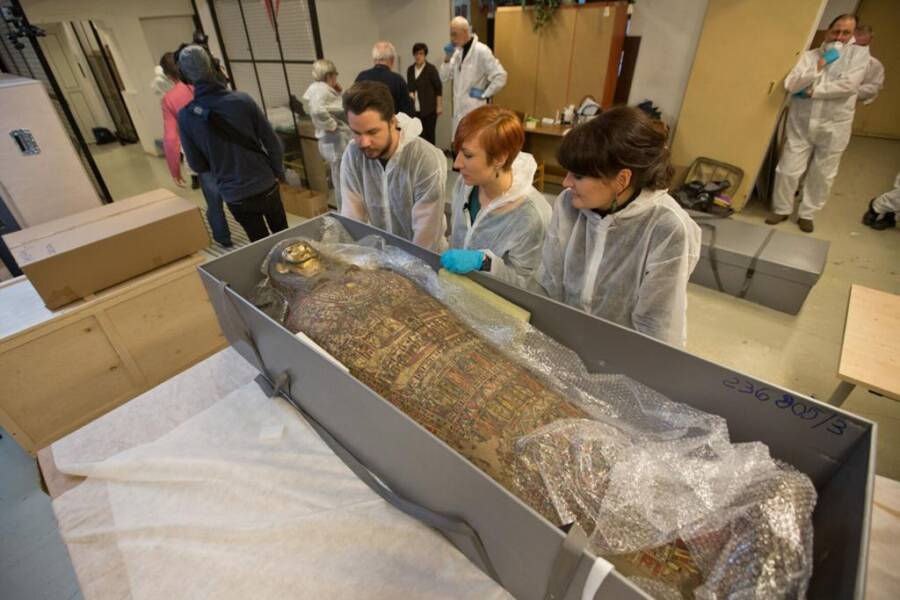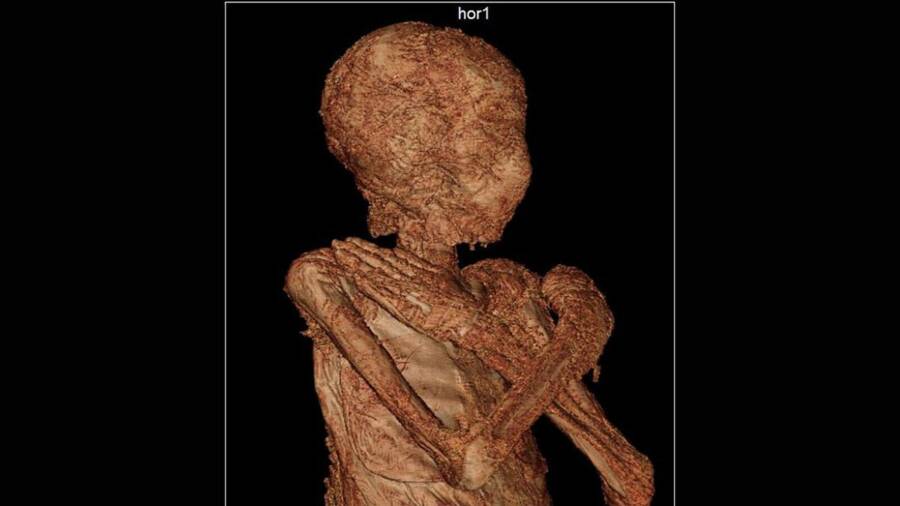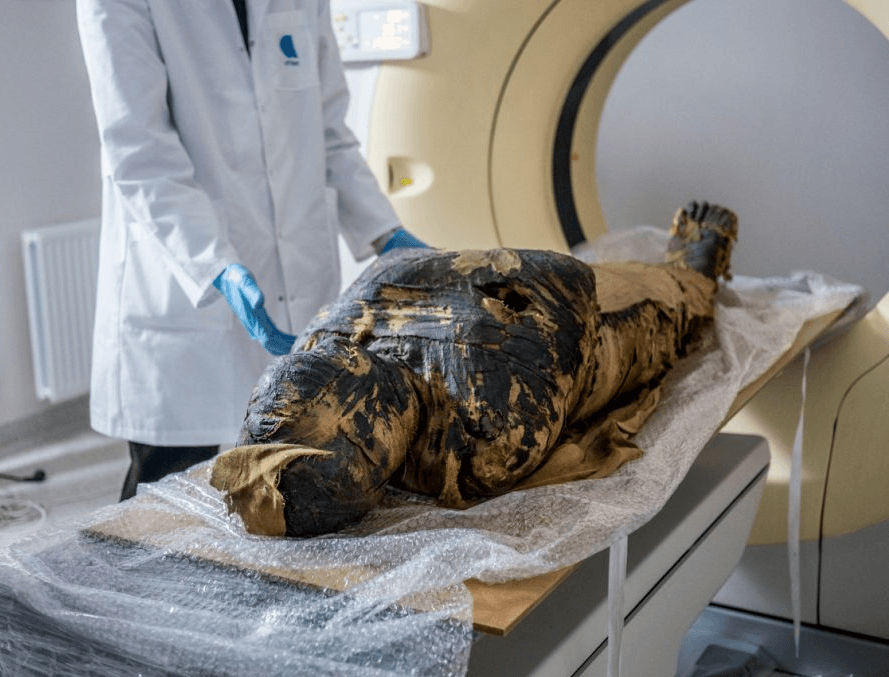Scientists say 10 percent of mummies are found in the wrong coffin because of grave robbers — and that's likely what happened to this woman.

Warsaw Mummy ProjectArcheologists peer at the female mummy in her coffin.
Wrapped in bandages and buried in pyramids, Egyptian mummies often seem like close-lipped envoys of an ancient era, filled with secrets they cannot tell. Recently, researchers found that one mummy held at the National Museum of Warsaw had more secrets than most. Not only was she a woman — but she was between 6.5 and 7.5 months pregnant.
“It’s like finding a treasure trove while you are picking up mushrooms in a forest,” said Dr. Wojciech Ejsmond, an archeologist and co-director of the Warsaw Mummy Project. “We are overwhelmed with this discovery.”
Another archeologist, Marzena Ożarek-Szilke, noted that the team had already wrapped up their research and was preparing to submit their findings when they noticed something peculiar about the mummy in question.
“We had the last look at the images and noticed a familiar image for parents of three children,” she said. “A tiny foot.”
Upon further investigation, the team found that the tiny foot belonged to a tiny fetus. And the mummy — long thought to be a male priest, based on the engravings outside her coffin — was a woman. She was likely between 20 and 30 years old when she died.
Although archeologists have come across burials of pregnant women from ancient Egypt, this is the first-known pregnant mummy.

Warsaw Mummy ProjectA scan of the pregnant mummy.
“It was complete surprise because we were looking for ancient diseases or causes of deaths,” said Ejsmond. “Also, we thought that this is a body [of] a priest.”
Instead, the archeologists determined that the woman was mummified around the first century B.C. She was wrapped in linens and plain-weave fabrics and buried with amulets — suggesting that she enjoyed a high status in Egyptian society. A 3D scan of the body clearly showed long, curly hair and mummified breasts.
But Ejsmonde had good reason for thinking otherwise. Translated hieroglyphs on her coffin revealed the name of an Egyptian priest, Hor-Djehuty. And radiological examinations in the 1990s had suggested to researchers that the mummy was a man.
However, the original team to examine the mummy — when she was donated to the University of Warsaw in 1826 — had labeled her as “the mummy of a lady.” Their note was discarded after the translation of the hieroglyphs.

Warsaw Mummy ProjectResearchers in 1826 correctly determined the mummy was a woman, but their notes were lost and scientists only last month realized the truth about the “priest.”
So, how did the pregnant mummy end up in the coffin of an Egyptian priest named Hor-Djehuty?
“This is one of the most complex matters,” said Ejsmond. “We know that in ancient times coffins were reused. Sometimes tombs were robbed and stolen so that they could be reused.
During the 18th and 19th centuries, mummies’ tombs were robbed and antiquity dealers were stealing precious items and replacing bodies.”
This mummy seems to have been a victim of such grave theft. Archeologists noted damage around the mummy’s neck, which suggests that robbers may have stolen some of her amulets. Ejsmond estimates that some 10% of mummies are found in the “wrong” coffin because of grave robbers.

Warsaw Mummy ProjectAn x-ray scan of the pregnant mummy.
Although they’ve cracked one mystery, archeologists examining the pregnant mummy have uncovered another. Scans of her body showed four mummified bundles — likely to be her lungs, liver, stomach, intestines, and heart. They had been embalmed and placed back in her abdominal cavity.
This was normal embalming practice. But why hadn’t the mummy’s ancient embalmers touched her fetus?
“This whole discovery brought our attention to the question of why [the fetus] was not removed,” said Ejsmond. “We don’t know why it was left there. Maybe there was a religious reason. Maybe they thought the unborn child didn’t have a soul or that it would be safer in the next world. Or maybe it was because it was very difficult to remove a child at that stage from the womb without causing serious damage.”
Researchers at the Warsaw Mummy Project hypothesized that ancient Egyptians viewed the unborn baby as, “still an integral part of the body of its mother since it was not yet born.”
Plus, ancient Egyptians believed that naming was an important part of being human. If the baby had not yet been named, it might not have been considered an individual apart from its mother.
“Thus, its afterlife could only have happened if it had gone to the netherworld as part of its mother,” the researchers stated.
For now, archeologists at the Warsaw Mummy Project are eager to see what the mummy might reveal about life in ancient Egypt — especially about women, prenatal care, and Egyptian ideas about the afterlife.
After reading about the pregnant mummy, see why experts were baffled by the mummies of Taposiris Magna — one of which had a golden tongue. Or, learn about the Qilakitsoq mummies which were so well-preserved scientists could determine their last meal.





